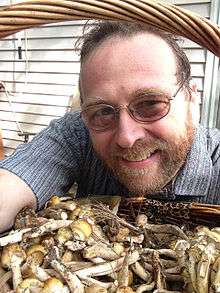Pavel Etingof
Pavel Ilyich Etingof (Russian: Павел Ильич Этингоф; born 1969) is an American mathematician of Russian-Ukrainian origin.
Pavel Etingof | |
|---|---|
 | |
| Born | 1969 Kyiv, Ukrainian SSR |
| Alma mater | Yale University |
| Awards |
|
| Scientific career | |
| Fields | Mathematics |
| Institutions | MIT |
| Thesis | Representation theory and holonomic Systems (1994) |
| Doctoral advisor | Igor Frenkel |
| Website | math |
Biography
Etingof was born in Kyiv, Ukrainian SSR, and studied in the Kyiv Natural Science Lyceum No. 145 in 1981-1984, and at the Department of Mathematics and Mechanics of the Taras Shevchenko National University of Kyiv in 1984-1986. He received his M.S. in applied mathematics from the Oil and Gas Institute in Moscow in 1989 and then went to the USA in 1990. In 1994 he received his PhD in mathematics at Yale University under Igor Frenkel with thesis Representation Theory and Holonomic Systems.[1] After his PhD, he became Benjamin Peirce Assistant Professor at Harvard University and in 1998 an Assistant Professor at MIT. Since 2005 he is a Professor at MIT. He is married to Tanya Javits-Etingof (1997–present) and has two daughters; Miriam (1998) and Ariela (2004).
Etingof does research on the intersection of mathematical physics (exactly integrable systems) and representation theory, e.g. quantum groups.
In 1999 he was a Fellow of the Clay Mathematics Institute.
In 2002 he was an invited speaker at the International Congress of Mathematicians in Beijing (On the dynamical Yang–Baxter equation). He is a Fellow of the American Mathematical Society.
In 2010, together with Slava Gerovitch he co-founded the MIT Program for Research In Mathematics, Engineering and Science (PRIMES) for high school students, and has since served as its Chief Research Advisor.[2]
In 2016 he became a fellow of the American Academy of Arts and Sciences.[3]
Works
- Quantum fields and strings: a course for mathematicians. Vol. 1, 2. Material from the Special Year on Quantum Field Theory held at the Institute for Advanced Study, Princeton, NJ, 1996–1997. Edited by Pierre Deligne, Pavel Etingof, Daniel S. Freed, Lisa C. Jeffrey, David Kazhdan, John W. Morgan, David R. Morrison and Edward Witten. American Mathematical Society, Providence, RI; Institute for Advanced Study (IAS), Princeton, NJ, 1999. Vol. 1: xxii+723 pp.; Vol. 2: pp. i--xxiv and 727–1501. ISBN 0-8218-1198-3, 81-06 (81T30 81Txx)
- with Frédéric Latour: The dynamical Yang–Baxter equation, representation theory, and quantum integrable systems, Oxford University Press 2005[4]
- with Igor Frenkel, Alexander Kirillov, Jr.: Lectures on representation theory and Knizhnik–Zamolodchikov equations, American Mathematical Society 1998[5]
- with Alexander Varchenko: Why the boundary of a round drop becomes a curve of order four, American Mathematical Society 1992[6]
- Calogero–Moser Systems and Representation Theory, European Mathematical Society 2007 (Zürich Lecture Notes in Advanced Mathematics)
- with co-authors: Introduction to Representation theory, Student Mathematical Library, American Mathematical Society 2011
- editor with co-editors: The unity of mathematics: in honor of the ninetieth birthday of I. M. Gelfand, Birkhäuser 2006
- editor with Shlomo Gelaki and Steven Shnider: Quantum Groups (Konferenz Technion 2004), American Mathematical Society 2007
- Tensor Categories. American Mathematical Society. 2015. ISBN 978-1-4704-2024-6..
References
- Pavel Etingof at the Mathematics Genealogy Project
- "World-class research ... in the 10th grade," MIT News (October 5, 2011)
- Newly Elected Members, American Academy of Arts and Sciences, April 2016, retrieved 2016-04-20
- Felder, Giovanni (2013). "Review: The dynamical Yang–Baxter equation, representation theory, and quantum integrable systems by Pavel Etingof and Frédéric Latour". Bull. Amer. Math. Soc. (N.S.). 50 (1): 181–186. doi:10.1090/S0273-0979-2012-01367-8.
- Chari, Vyjayanthi. "Review: Lectures on representation theory and Knizhnik–Zamolodchikov equations" (PDF). Bull. Amer. Math. Soc. (N.S.). 37 (2): 161–167. doi:10.1090/s0273-0979-00-00853-3.
- Why the boundary of a round drop becomes a curve of order four, AMS Bookstore